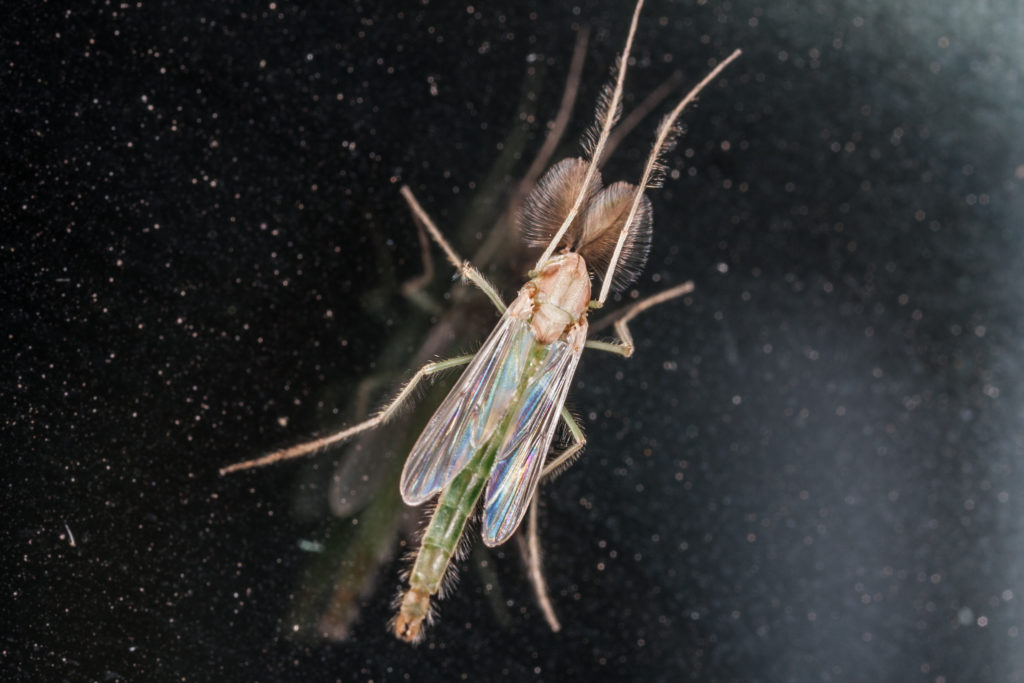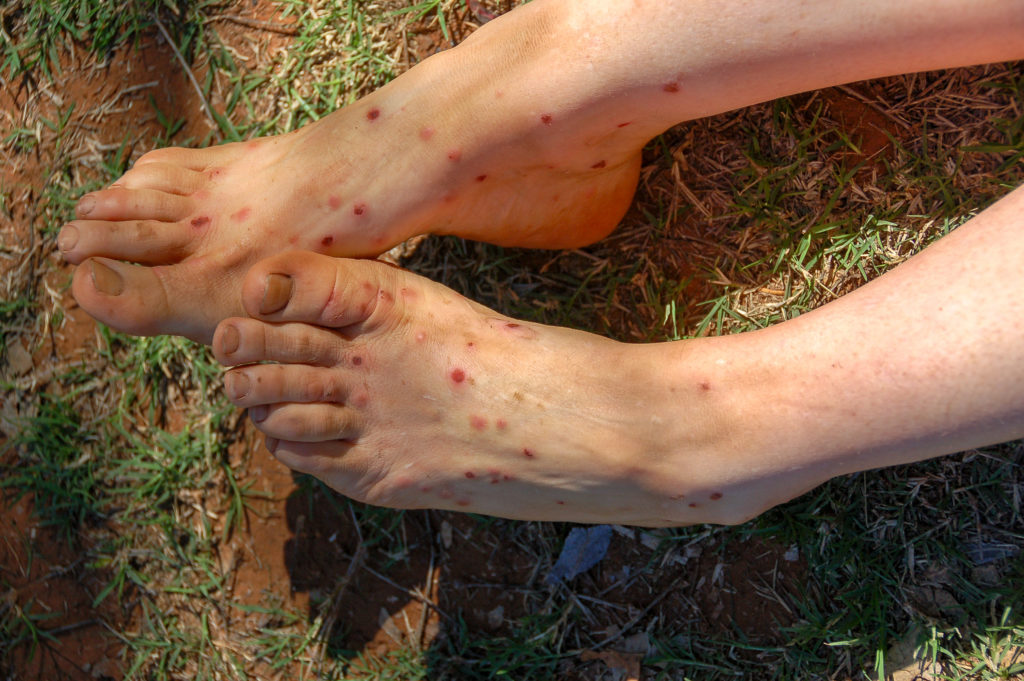No-See-Ums are annoying, disruptive, and hard to get rid of.
But that doesn’t mean you should give up.
Don’t spend any more time looking for the best resources. Here we’ll go over the best ways to get rid of no-see-ums.
Let’s get started.
What Are No-See-Ums?
No-see-ums are a type of fly that are known for their painful bites.
They belong to a species of fly called midges. There are over 5,000 different species of midges. They live across the globe except for Antarctica.
Many people think that they are a type of mosquito due to their bites. Although they bite for the same reasons as mosquitos, they don’t transmit any diseases.
What Do No-See-Ums Look Like?

Midges or no-see-ums look very similar to mosquitos.
There are a few key distinctions you can look for when you see a midge.
First, midges are typically much smaller than mosquitos.
They also have wings without any hairs or proboscis.
They tend to be longer and narrower than mosquitos.
Why Do No-See-Ums Bite You?
Only female no-see-ums bite. Females bite because they need blood to reproduce.
Female midges bite humans and nearly any other mammal in order to get the blood they need to reproduce.
They tend to attack in large groups. All females are in search of blood so they can reproduce as quickly as possible.
Adults only live a few weeks but are capable of reproducing between five and ten times during their lifespan.
Males don’t bite. Since they don’t reproduce they don’t require blood.
In order to survive, both males and females consume nectar.
How To Identify No-See-Um Bites?

No-see-um bites are known for their red welts that are painfully itchy.
Midges travel in large groups and usually attack in large groups.
This means that bites typically occur in clusters.
They will typically bite the hands, ankles, legs, and neck, targeting any exposed skin.
Some people can have more severe reactions that cause increased swelling and liquid-filled blisters.
What Are Midges Attracted To?
Male and female midges are attracted to two different things.
Female midges are attracted to humans. In particular, they are attracted to three things that humans emit:
- CO2
- Body Heat
- Human Scent
Females use these three signals to track humans and bite them.
Males are attracted to pollen and nectar. Midges survive off of nectar and pollen.
How To Get Rid Of No-See-Ums
1. Kill The Larva
The first step you can take to getting rid of no-see-ums is killing the larva. This will allow you to attack the problem at the source. Sine no-see-ums only live for around 5 weeks. Attacking the larva will stop the population in its tracks.
If no-see-ums are not continually reproducing, over-time they will die off.
The best way to get rid of midge larva is to treat the water with an insecticide. Similar insecticides are used when treating mosquito larva.
Some potential insecticides that you can include are:
- IGR’s
- BTI
- Spinosad
Treating the water with an insecticide is feasible when you can identify sources of water that could be locations where midges would breed.
If you live next to large bodies of water or you can’t identify the sources of water then killing the larva isn’t a viable option.
2. Eliminate Stagnant Water
Midges require moisture to lay their eggs. Midges commonly choose to lay their eggs near
stagnant water or inside stagnant water.
Eliminating stagnant water is a great way to eliminate the possibility of midges breeding and expand the population in or around your home.
Some common places you might find stagnant water include:
- Birdbaths
- Pet water bowls
- Potted Plants
- Gutters and downspouts
- Corrugates pipes or drains
- Other clutter around your home or outside your home
- Sheds or patios
3. Eliminate Mud and Moisture soil
Midges don’t just lay their eggs in large bodies of standing water. They can also lay their eggs anywhere there is moisture.
Large bodies of water are not necessary. Areas that don’t hold direct water, but their moisture is present.
This means that poor drainage areas that are causing overly moist areas around your home can sustain midges.
The best way to eliminate mud or areas of excess moisture is to remove the top layer of soil. Then replace this area with gravel or fresh soil.
This will help reduce the moisture in the immediate areas without much effort. For a long-term solution, you must recognize the source of the moisture.
Whether it’s a leaking pipe or improper drainage, the problem’s source must be addressed, or the moisture will continue to return.
4. Fix and Replace all Screens
Midges are smaller than you’d expect. They only measure between 1 and 3 mm in size. This means that if there are gaps or tears in any screens around your home will give midges easy access to the inside of your home.
The standard mesh screens that come with most homes are not fine enough. These mesh screens are typically big enough that midges can fly directly into your home.
This leaves your home extremely vulnerable if there an infestation. The best way to avoid this issue is by installing and replacing all screens around your home.
The standard mesh size is 18. To keep midges out, you need a mesh size of 35. To ensure that you keep midges out, you want to at least half your mesh openings size.
6. Use Mosquito Traps
Mosquito traps are a great way to get rid of flying midge. Mosquito traps are great because they typically use several lures and trapping methods to increase their effectiveness.
Mosquito traps are great because they are easy to move and highly adjustable.
Since midges and mosquitoes are attracted to the same things, this makes mosquito traps effective at eliminating midges as well.
Mosquito traps are designed to lure, trap, and kill host-seeking female mosquitoes.
Some common attractants are scents, heat, and carbon dioxide. For instance, most of these traps lure mosquitoes by mimicking the CO2 we produce when exhaling.
But as they enter through the tight wire or mesh grid, they are either zapped or trapped.
Some mosquito traps use an electric grid to zap mosquitoes upon contact.
7. Use Repellent Sprays
Repellent sprays are another useful treatment that you can use to get rid of no-see-ums. The repellent spray will keep no-see-ums away, but it won’t kill them.
The downside of using repellent sprays is that you need to apply the insecticide on all the surfaces outside your home, including the walls, grass, and plants.
For the repellent to work, they must land on the surface. This will then cause them to leave.
If there are gaps in coverage, the midges can tend to group themselves around these lapses in coverage.
These repellent sprays are not always a safe alternative, especially if you have children or pets that frequent outside your home.
When applying repellent sprays, it’s best to use a pressurized sprayer and apply it to your home’s surrounding area.
8. Apply Chemical Insecticide
Another popular option for getting rid of no-see-ums is to apply chemical insecticide around your home.
This is commonly done using foggers. This requires you to fog all surfaces that midges come in contact with. These insecticides are only effective if you spray midges directly or they come in contact with a surface that has insecticide.
This is typically done around the entire house on every surface.
Applying chemical insecticides are effective in the short term. They will reduce the population, and the mosquito population will likely be reduced for several weeks.
But, fogging does not attack the source of the problem. Once mosquitos begin to mature, the population will return to your home.
When applying chemical insecticides, be sure to use proper protective equipment and follow the application instructions.
Frequently Asked Questions (FAQ)
Do No-See-Ums suck blood?
Yes, female no-see-ums suck blood. They suck blood to get the necessary enzymes they need to reproduce. Without a blood meal midges can’t reproduce.
Males, on the other hand, don’t suck blood. They feed on pollen and other sugars.
Do No-See-Ums Lay Their Eggs On People?
No, no-see-ums don’t lay eggs on people. For no-see-um eggs to survive they require a source of consistent moisture.
Skin does not provide sufficient moisture or protection for their eggs to survive.
Midge eggs are excreted from the abdomen, they are not inserted using their mouth. They have no way of injecting eggs into human skin.
Are Chigger and Midges The Same?
No, midges and chiggers are different. Midges are a biting fly, while chiggers are a species of mite.
They are mistaken for one another because of how similar their bites look.
Both midges and chiggers bite in clusters and leave red, swollen welts.
When are Midges Most Active?
Midges are most active during the warm months of the year. Males typically emerge during early May.
Female activity increases during June and July.
The warm weather produces conditions that are ideal for midges.
During early summer there sufficient water sources available for midges to survive.
Are biting Midegs Dangerous?
Biting midges are not dangerous in the same way mosquitoes are.
Midges don’t transmit any diseases with their bites. The main danger that midges cause are uncomfortable and painful bites.
These bites typically go away within several days to a few weeks.
In certain cases, allergic reactions can cause worse reactions to biting midges.
In either situation, midges bites are not serious and will subside with time.
Why are No-See-Ums itchy?
No-see-um bites are itchy because of their saliva. When midges bite they inject saliva into the skin.
Their saliva acts as an anticoagulant that helps keep the blood flowing. This allows them to suck enough blood for them to continue reproducing.
The remaining saliva, in particular, the proteins it contains causes the itchy feeling felt by midge bites.
How To Stop Midges From Biting You?
One of the most common ways to prevent mosquitoes from biting you is by applying chemical repellents that contain DEET, picaridin, or PMD.
DEET
DEET is one of the most effective ways to repel mosquitos and most flying insects.
DEET does have its drawbacks.
It does have a strong odor. DEET can also damage some plastics and other synthetic materials.
PMD
PMD is a natural oil extracted from the eucalyptus plant.
It’s a natural alternative to DEET repellant.
Researchers found that repellents containing lemon eucalyptus oil are just as effective and long-lasting as products containing DEET.
Wear Light Colored Clothing
Mosquitoes are attracted to black, deep blue, and red. To keep yourself from being a target, stick to light colors.
Wear Loose, Long Sleeve Shirts, And Long Pants
Mosquitoes target exposed skin. To keep them away, cover as much of your skin as possible. You’ll also want to wear thicker fabrics when you can. Looser clothing is also better than one that fits tightly on your body.
